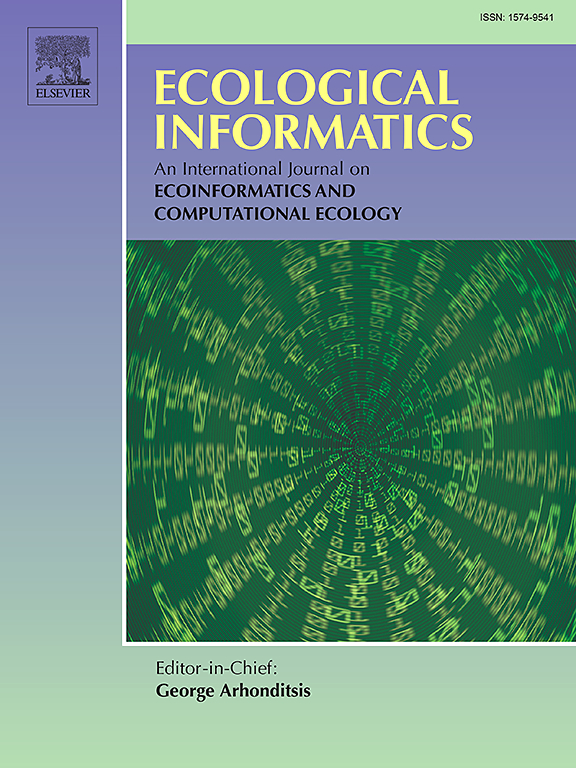ArcticSoundsNET: BirdNET嵌入有助于改进北极物种的生物声学分类
IF 7.3
2区 环境科学与生态学
Q1 ECOLOGY
引用次数: 0
摘要
近年来,深度学习已成为处理大型生态监测数据集的流行解决方案。这种使用的增加导致了各种数据类型和分类群的全球分类模型,例如BirdNET,它根据声学数据对6000多种鸟类的发声进行了分类。这些全局模型对于迁移学习是有用的预训练模型,允许研究人员更容易地开发专门针对其数据集的分类器。然而,这些模型的发展取决于能否获得全面、高质量的训练数据,而这些数据很难获得、产生和使用。我们提出了一种新的管道,用于在最小的人为监督下从大型未标记数据集创建训练数据。我们利用这条管道和BirdNET作为基础模型,开发了一个基于迁移学习的模型ArcticSoundsNET,该模型使用了阿拉斯加北极海岸平原205个地点的声学监测数据。我们比较了ArcticSoundsNET和BirdNET的性能,以评估我们的管道的有效性和新模型的成功。我们发现ArcticSoundsNET在我们的数据中对鸟类发声的检测和分类能力大大超过了BirdNET (ArcticSoundsNET的AUC ROC = 0.888, BirdNET的AUC ROC = 0.593)。重要的是,我们开发训练数据集的方法广泛适用于没有大量标记数据的生态学家,促进了特定任务分类模型的创建。开发这样的模型是利用大型声学数据集支持关键物种和栖息地的生态保护的重要步骤。本文章由计算机程序翻译,如有差异,请以英文原文为准。
ArcticSoundsNET: BirdNET embeddings facilitate improved bioacoustic classification of Arctic species
In recent years, deep learning has become a popular solution for processing large ecological monitoring datasets. This rise in use has resulted in global classification models for a variety of data types and taxa, such as BirdNET, which classifies vocalizations of more than 6000 avian species from acoustic data. These global models can be useful pre-trained models for transfer learning, allowing researchers to more easily develop classifiers specialized to their datasets. However, the development of such models hinges on the availability of comprehensive, high-quality training data, which can be difficult to acquire, produce, and use. We present a novel pipeline for creating training data from a large and unlabeled dataset with minimal human oversight. We used this pipeline and BirdNET as our base model to develop a transfer-learning-based model, ArcticSoundsNET, using acoustic monitoring data from 205 sites across Alaska's Arctic Coastal Plain. We compared performance of ArcticSoundsNET with that of BirdNET to evaluate the effectiveness of our pipeline and success of the new model. We found that the ability of ArcticSoundsNET to detect and classify avian vocalizations in our data greatly exceeded that of BirdNET (AUC ROC = 0.888 for ArcticSoundsNET, AUC ROC = 0.593 for BirdNET). Importantly, our method for developing a training dataset is widely applicable for ecologists who do not have large amounts of labeled data, facilitating the creation of task-specific classification models. Developing such models is an essential step in using large acoustic datasets to support ecological conservation of critical species and habitats.
求助全文
通过发布文献求助,成功后即可免费获取论文全文。
去求助
来源期刊

Ecological Informatics
环境科学-生态学
CiteScore
8.30
自引率
11.80%
发文量
346
审稿时长
46 days
期刊介绍:
The journal Ecological Informatics is devoted to the publication of high quality, peer-reviewed articles on all aspects of computational ecology, data science and biogeography. The scope of the journal takes into account the data-intensive nature of ecology, the growing capacity of information technology to access, harness and leverage complex data as well as the critical need for informing sustainable management in view of global environmental and climate change.
The nature of the journal is interdisciplinary at the crossover between ecology and informatics. It focuses on novel concepts and techniques for image- and genome-based monitoring and interpretation, sensor- and multimedia-based data acquisition, internet-based data archiving and sharing, data assimilation, modelling and prediction of ecological data.
 求助内容:
求助内容: 应助结果提醒方式:
应助结果提醒方式:


